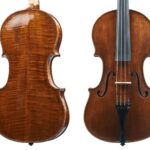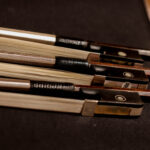How To Choose The Perfect Violin Strings
Back to BlogChoosing The Perfect Violin Strings
Selecting the right violin strings is crucial for unlocking the full potential of your instrument. The right violin strings can significantly enhance your violin’s sound, responsiveness, and overall playability. Whether you’re a beginner or an experienced player, understanding how to choose the right violin strings is essential for achieving the best musical results.
This guide will walk you through the important factors to consider when choosing the correct violin strings, helping you make an informed decision tailored to your preferences and playing style.
The Importance of Choosing the Right Violin Strings
Choosing the right violin strings is vital for ensuring your instrument performs at its best. Just as a car’s performance is influenced by the type of tires it has, a violin’s sound and playability are greatly affected by the strings you choose.
The right violin strings can enhance tonal quality, improve responsiveness, and make your playing experience more enjoyable. Conversely, the wrong choice can lead to a lackluster sound and difficulty in playability. The selection of strings is a critical aspect of violin maintenance and performance, and understanding how to choose the right violin strings ensures that your violin meets your musical needs and preferences.
Basic Types of Violin Strings
Violin strings come in several types, each offering unique tonal characteristics and playability features. Understanding the different types of strings available will help you make an informed decision. Here are the main types of violin strings:
Gut Core Strings
These strings are made from sheep intestines and provide a warm, rich sound with complex tonal qualities. They are favored by many classical musicians for their nuanced and expressive sound. However, gut core strings require more maintenance due to their sensitivity to alter in temperature and humidity. They are also less stable in pitch compared to other types of strings. If you prefer a traditional, warm tone and are willing to manage the maintenance, gut core strings might be ideal.
Steel Core Strings
These strings are constructed with a steel core wrapped in winding. They are known for their bright, focused sound and excellent durability. Steel core strings offer excellent pitch stability and are less affected by environmental conditions, making them a reliable choice for many players. They are particularly suitable for those who need strong projection and consistent performance, especially in varied climates. Steel core strings are worth considering if you need a robust and reliable string that can withstand changing conditions.
Synthetic Core Strings
Synthetic core strings are designed to replicate the tonal qualities of gut strings while providing greater stability and durability. They are made from composite materials that offer a balanced sound and resistance to temperature and humidity changes. Synthetic core strings provide a middle ground between gut strings’ warmth and steel core strings‘ stability. They are a popular choice for players seeking a versatile and stable option without the maintenance demands of gut strings.
Steps to Choosing the Right Violin Strings
These steps will help you choose the right violin strings:
Consider Your Violin’s Sound Characteristics
Every violin has its unique sound character, which can be bright, warm, or somewhere in between.
When choosing the right violin strings, consider how they complement your violin’s natural sound. For instance, if your violin has a bright sound, you might select warmer sounding strings to add depth and richness. Conversely, if your violin’s tone is already warm, bright strings can help to clarify and articulate the sound. Matching the strings to your violin’s inherent tonal qualities will help you achieve a more balanced and pleasing sound.
Assess Your Playing Style
Your playing style and personal preferences will influence your choice of strings. Consider whether you prefer higher tension strings, which offer more resistance and a firmer tone, or lower tension strings, which are easier to play and offer a softer sound.
Think About String Gauge
String gauge refers to the thickness of the strings. The gauge can significantly impact the tone and playability of your violin. Thicker strings generally produce a richer, warmer sounding but can be harder to play, while thinner strings offer easier playability and a brighter tone. Experimenting with different gauges can help you find the right balance between tone and playability. Choosing the appropriate gauge will ensure you have the right feel and sound for your playing needs.
Evaluate the Sound Quality
Consider the type of sound you prefer and how it aligns with your violin’s natural tone. Bright strings produce a crisp, clean sound, ideal for certain styles, but may become shrill if paired with a bright violin. Warm strings offer a richer tone but might become muddy with a warm-sounding violin. Consider whether you want a clean, focused sound or a complex, rich tone, and select strings that help you achieve that desired sound. The right choice will enhance your musical expression and overall performance.
Experiment with Different Strings
Finding the perfect strings for your violin often involves some experimentation. Try various strings and brands to see which suits your instrument and playing style best. Experimenting with different strings will help you understand how different strings affect your violin’s sound and playability. Be open to trying new options and making adjustments based on your experiences. The best strings for you are those that make you feel comfortable and enhance your musical performance.
How to Adjust Your Playing Technique for Different Strings
Different strings require adjustments in playing technique to maximize their potential. Use a slightly heavier bowing technique for higher tension strings to match the increased resistance. Lower tension strings may benefit from a lighter touch and quicker bow strokes. When switching between thicker and thinner strings, adjust your bow pressure and angle to accommodate the variations in string gauge. Experiment with your technique to find the optimal balance and responsiveness with each string type, enhancing your overall playing experience.
Conclusion
Choosing the right violin strings is more than just a technical decision; it’s essential to achieving your desired sound and playability. By understanding the types of violin strings available, considering your violin’s sound characteristics, and evaluating your playing style, you can make an informed choice that enhances your musical performance. Whether you prefer the warmth of gut core strings, the brightness of steel core strings, or the balanced nature of synthetic core strings, selecting the right strings will elevate your playing experience. Regular experimentation and understanding of your preferences will ensure that your violin performs at its best, allowing you to enjoy a more prosperous, expressive musical journey.









